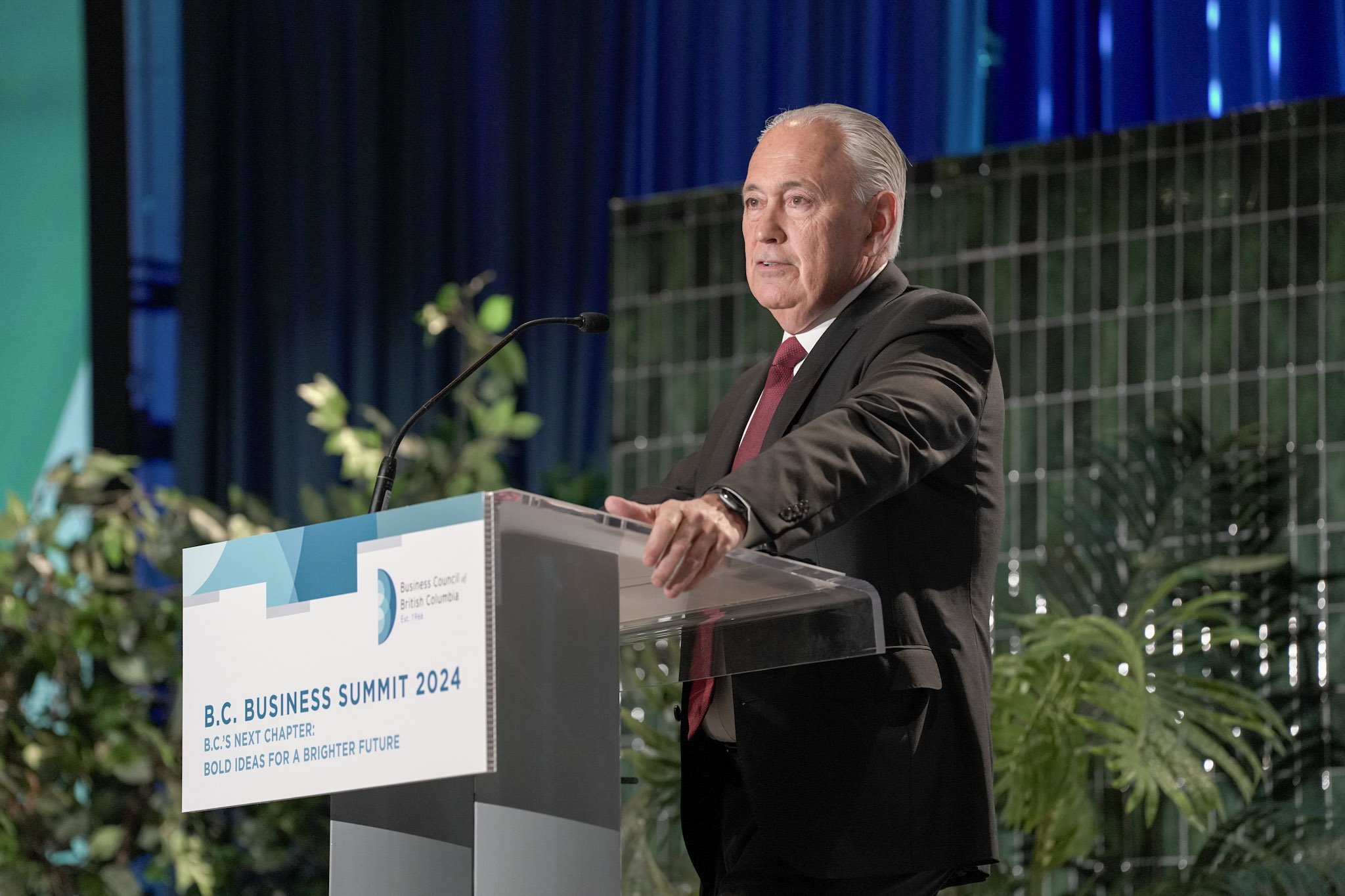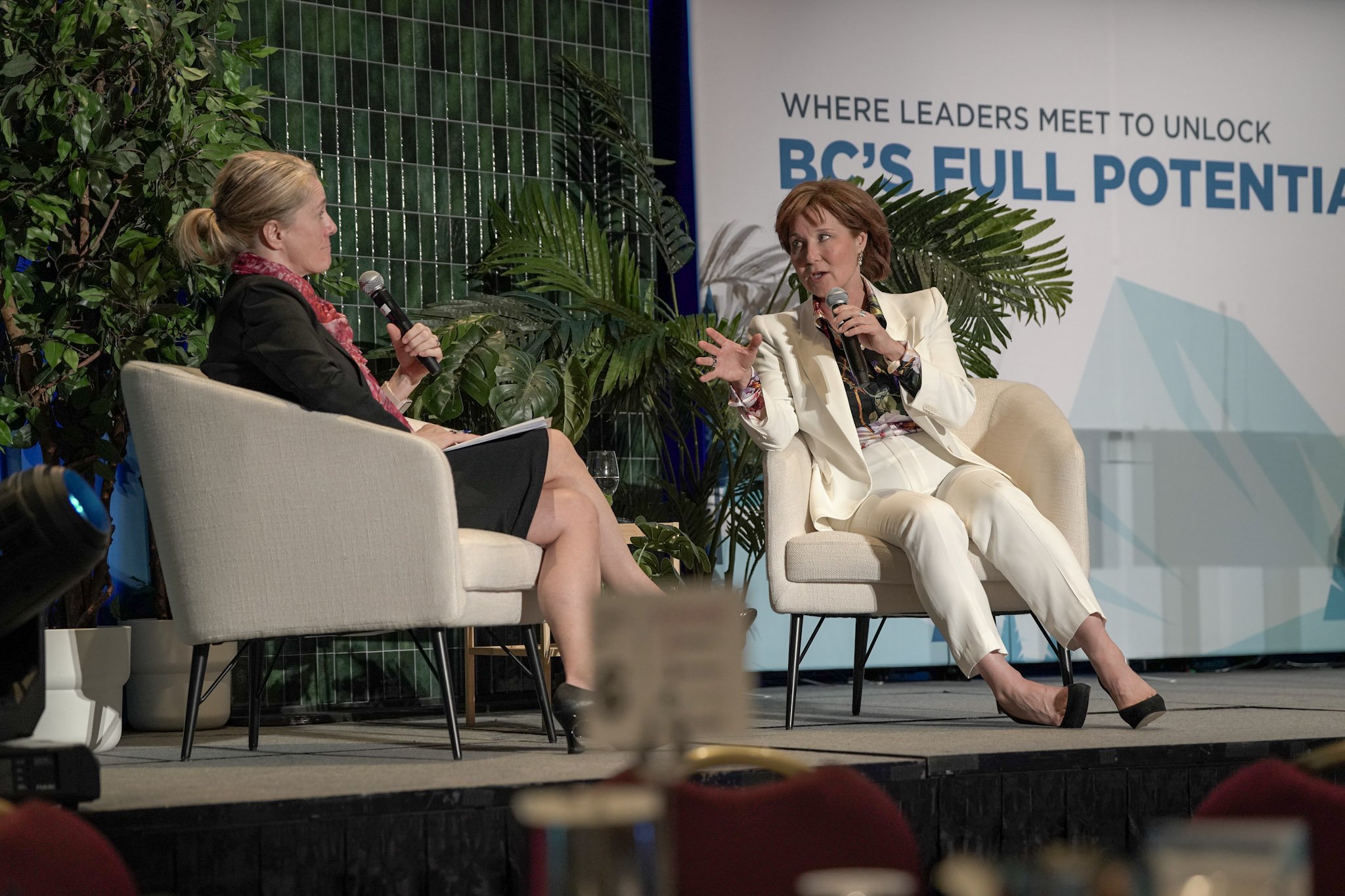Bold Ideas for a Brighter Future
The Business Council of British Columbia (BCBC) recently hosted its annual Business Summit. This year’s theme was B.C.’s Next Chapter: Bold Ideas for a Brighter Future, where speakers, panelists and the audience were all challenged to come up with ideas for a brighter future. The goal was to compile the ten leading ideas to share with all political leaders in B.C. in advance of the provincial election this fall.
What did we hear?
Over 300 business leaders and students agreed that B.C. has many strengths, including a well-educated population, a diversified economy, stable institutions, and proximity to expanding global markets. We also heard a few fun facts about the province—B.C. is home to over 40,000 islands and 50,000 distinct species.
The need for bold ideas came into sharp focus when Greg Lyle, President of the Innovative Research Group, documented the steep decline in satisfaction with Canadian living standards since 2007 across all generations. His research finds 49 per cent of Generation X reported being satisfied in 2007 compared to only six per cent today. Greg commented that “for most of our adult lives, we took prosperity for granted.” Shachi Kurl, President of the Angus Reid Institute, shared that recent polling shows 36 per cent of British Columbians are currently considering leaving the province (over 50 per cent of those aged 18-40).
Chart: Innovative Research Group Inc. Source: National online survey conducted between January 18-29, 2024
Economic data presented by BCBC’s David Williams confirmed stagnant per capita income for B.C. and Canada. This, along with inflation, helps explain why affordability tops the list of concerns in recent polls, including the impromptu one we conducted at the conference. We learned that British Columbia’s per capita income is currently 48 out of 60 provinces and U.S. states, just below Kentucky and ahead of Idaho.
Further underscoring the need to focus on improving economic conditions, we heard from University of Calgary economist Jack Mintz that Canadian incomes relative to the U.S. are continuing to slide from 90 per cent in the past to around 70 per cent today.
From the day’s robust discussion and contributions from the panelists and keynote speakers, the following list of ideas for a brighter future emerged. Our hope is that they foster discussion and will be turned into actions by our political leaders.
Ten ideas for a brighter future
1: Focus on growing the economy
The importance of generating more income was a message from both former Premiers who happen to share the same last name. Glen Clark said: “Given our serious economic challenges, all government actions need to be viewed through an economic growth lens.” Christy Clark said: “The only way to eliminate poverty is to create wealth.”
2: Provide policy stability to attract capital
Glen’s comments focused on the need for a period of policy stability where we stop making changes and let industry catch up. Glen emphasized that “capital is a coward” and that it goes where things are easiest and not where things are frightening. Shannon Young, VP with Petronas echoed this sentiment when she said that as business looks at countries around the world, they probably won’t go where they aren’t wanted. A quickly changing environment where the rules of the road are continually shifting is not conducive to attracting the capital investment needed to keep the economy growing.
3: Embrace the resource sector to “get out of the funk”
The resource sector has always been a significant comparative advantage for the country and the province. Jack Mintz and fellow panelists Shannon Young, and Karen Ogen, CEO of the First Nations LNG Alliance championed the idea of promoting the sector to address our serious economic challenges (or what Jack called “the funk”), help the world move to cleaner energy, and contribute to economic reconciliation.
Jack echoed Glen’s earlier comment that, “the thing that drives high paid jobs is our natural resource sector,” pointing out that resource sector jobs have the highest level of labour productivity. Karen highlighted the benefits of resource development partnerships for Indigenous communities. Projects provide the economic resources required to build more houses, invest in education, and support healing from intergenerational trauma.
Keynote Speaker: Former Premier Glen Clark
Left to right: Stewart Muir, Shannon Young, Jack Mintz and Karen Ogen.
4: Look for opportunities to grow all industries in the province
One of B.C.’s strengths is its diverse economy. Our exports range from forest products and natural gas to agriculture and biotechnology. A key message from BCBC’s Chief Economist Ken Peacock is that we should be looking to grow all export sectors.
B.C. International Exports 2019*, $ Millions and Sector Share of Total Exports (%) Source: Statistics Canada
We heard from Gavin Dew, Chief Strategic Advisor for the Abbotsford Tech District about the serious impediment that what he described as “slow maybe” review processes are to investment. They are a drag on our economy and diminish opportunities for the next generation. Unfortunately, after the Summit, Gavin’s “slow maybe” development application process turned into a “definitive no.” After four years of delay and uncertainty, Abbotsford City Council voted against proceeding with the Tech District project, an innovative collaboration that would have resulted in billions in new investment that would have bolstered innovation and growth in Agri-Tech, built new housing, delivered education programs and created jobs. The project, which also had a focus on food security, had 93 per cent support among residents with an opinion. Gavin also flagged B.C.’s need for a “Guelph of the West” to elevate agricultural education and innovation in our post-secondary system, as well as the need to unlock more value-added food processing on agricultural land.
Simon Pimstone, Founder and CEO of Xyon Health challenged the audience to think about better incentives to attract and retain management talent to the region—something critical to scaling successful companies.
5: Share revenues on stumpage and royalties with Indigenous communities
Glen Clark pointed out that industry can’t pay extra fees on top of stumpage and royalties for resource development while remaining competitive. He made a case for prioritizing revenue sharing over changes to land management as we move forward with reconciliation and becoming true partners with Indigenous communities. He believes this would “unleash enormous potential” and help grow the economic pie.
6: Ensure climate policy creates economic and environmental win-wins
Both Shannon and Karen emphasized the win-win for our economy and the environment when we export our energy to countries who could reduce emissions by switching from coal to natural gas. Glen Clark asked, “What’s the plan?” when it comes to the question of how we balance the economic importance of our energy industry with the need to address climate change. He said that we need a period to “pause and reflect” and ensure that the “costs and consequences” of policies in this area are considered and included in the plan.
7: Create innovative new partnerships to improve healthcare results for patients
During the Turning Healthcare Challenges into Opportunities panel, Sue Paish, CEO of DIGITAL, asked what it would take to have the highest performing healthcare system in the world by 2034. Panelists, including Victoria Lee, President and CEO, Fraser Health Authority, emphasized finding novel ways to collaborate, disrupt and create “radical partnerships.”
As an example, Ohad Arazi, president and CEO of Clarius Mobile, worked with the Rural Coordination Centers of British Columbia and DIGITAL to deploy his innovative handheld ultrasound device to 150 clinicians in rural communities. The technology resulted in better access to care, decreased hospitalizations and reduced costs.On the opportunity for partnerships theme, Sue told us that we live in one of the most demographically diverse countries in the world and that we have extensive health data that can help advance research yet we struggle to leverage this unique combination to find new therapies.
Sue summarized the discussion by noting that: Canada can be at the top of healthcare rankings if we do “more, better, faster, together.”
Left to right: Sue Paish, Dr. Victoria Lee, Ohad Arazi and Leanne Hachey.
Left to right: Lisa Sparrow and Christy Clark
8: Use doctor’s time more efficiently, following the Nova Scotia example
Leanne Hachey, Executive Director with the Province of Nova Scotia, shared the incredible story of how Nova Scotia is freeing up doctor’s time by reducing and streamlining paperwork. Working with doctors they identified 50 processes that could be improved. They estimate that just fixing one form that was commonly referred to as the “damn blue form” freed up 60,000 hours per year across the system or the equivalent of more than 100,000 patient visits. She reported the province is on track to reduce the unnecessary burden on doctors by 80 per cent by the end of the year, the equivalent of 1.2 million patient visits. The initiative is helping more patients find family doctors and reducing doctor burnout.
9: Modernize our regulatory environment to better serve the public interest
Leanne explained the importance of “seeing the regulatory environment as an integral part of social and economic prosperity.” This means tracking, monitoring, and evolving it. Reporting directly to the Premier’s office has helped maintain a strong focus on this for her department. It also involves adopting new technology, digitizing processes, and leveraging AI to improve outcomes.
All agreed that technological innovation and modernizing systems that are decades old and still heavily paper-based can deliver enormous benefits.
10: Create space for bold conversation
Collaboration and creating the space for exchange, and disagreement, was a theme running throughout the conference. Lisa Sparrow, President & CEO of Corix and Chair of BCBC said “to have bold ideas, we need to have bold conversations,” as she reflected that business concerns tend to get watered down in conversations with government and the public.
At BCBC, we are committed to bold conversations, as we believe this is where hope for a better, more prosperous future lives. We invite you to continue this and other conversations.






